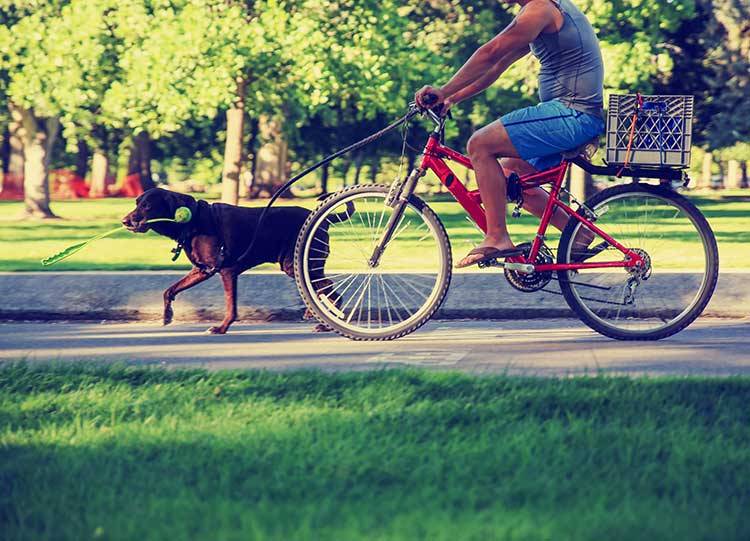Biking With Dogs Safely
As temperatures warm up and daylight lingers just a bit longer, pet owners are taking advantage of the warmer months with their dogs. While many pet owners choose to go on a walk, some enjoy biking with their dogs. Before grabbing your dog and bicycle, check out these dog safety tips first.
1. Size of Dog Matters
When humans pedal bikes, they move really fast, so only bike with a dog that can keep up. Think twice before exercising with an energetic Chihuahua, terrier or hyperactive young puppy. Small dogs must run at maximum capacity during a bike ride, and it’s impossible for them to comfortably maintain this speed.
Additionally, biking with a dog under two years old is highly discouraged because adolescent dogs are still growing, and high impact exercise can cause permanent damage. Ideally, it’s best to bike ride with healthy medium or large-sized dogs over two years old.
2. Introduce Dog to Bike First
Bikes are spooky to dogs, especially if dogs haven’t been introduced to one before. Think about it from a dog’s perspective: Bikes are big and move awkwardly plus they can run over dog toes.
To get your dog used to a bike, push your bike alongside slowly during a walk. If your dog still avoids your bike, have a friend push your bike during walks. Once your dog is comfortable with a moving bike right next to him, it’s time to bike slowly.
3. Position is Key
Teach your dog to hang out on the side of your bike. Your dog should not cross over in front while you’re riding. Better yet, use a safety device to hold your dog’s leash in place. This way, you can use both hands to steer your bike.
My favorite is the Springer Dog Exerciser. This device attaches to your bike and keeps your dog safely away from moving bike wheels. Before riding off into the sunset, attach your dog to this safety device and push your bike around for a few days.
4. Start Slow
Once you’ve installed a bike safety leash attachment and your dog is comfortable walking next to a moving bike, it’s time for a slow and short bike ride. Start by pedaling slowly up and down your driveway, which includes turns to the left and right. Reward your dog with tiny bits of yummy treats for moving with the bike.
After a few practice sessions on your driveway, try biking with your dog about a block away from your home. Continue to move slowly, so your dog learns to enjoy jogging alongside your bike.
Increasing distance and duration will slowly build your dog’s endurance. Each week, add 2-3 minutes to your bike ride. Don’t expect your dog to run at maximum speed for longer than a few minutes, so slow down and provide multiple breaks for your dog. Offer your dog plenty of water and potty breaks during exercise sessions. Take it slow.
5. Skip Warm & Hot Days
When it’s above 80 degrees, it’s probably a bit too warm for long bike rides with dogs. Your dog is covered with a fur coat that traps heat and causes him to warm up quickly. During hot summer days, bike ride with your dog early in the morning. If you’re biking with your dog at night or during dark early mornings, ensure your bike and your dog’s collar contain reflective strips. Better yet, skip hot and humid days.
6. Check Paw Pads Frequently
Your dog’s paw pads will take a beating during bike rides, especially on concrete and asphalt roads. Starting slowly provides time for a dog’s paw pad to adjust to rough surfaces, but sometimes it’s too much.
Before a bike ride, stand on a sidewalk or road with bare feet. If you’re unable to stand on it yourself, then your dog should not run or walk on it. Hot pavement will burn pads, but excessive running on hard surfaces can burn pads too. Check your dog’s paw pads often during bike rides. Choose sidewalks that have grassy areas. These will be much easier on your dog’s paw pads.
7. Allow Your Dog to Set the Pace
When walking, jogging or biking with a dog, it’s important to allow your dog to set the pace. Dogs feel most comfortable trotting when they’re able to cover ground effortlessly. Running at maximum speed is too much for a dog, so watch your dog’s gait as you vary speeds on your bike. Slow down and watch your dog’s movement for an easy trot, then adjust your pedaling speed to maintain that trot.
Post pictures of your dog biking with you below. We want to see!





